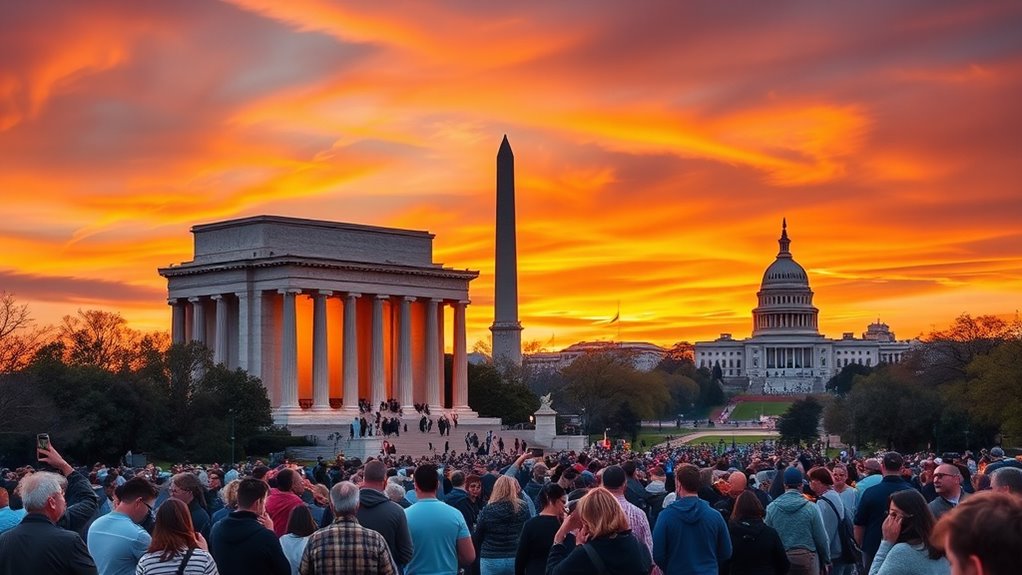The history and culture of the USA are shaped by its colonial beginnings, revolutionary fight for independence, and Civil War struggles for equality. You’ll see how industrialization, wars, and social movements transformed society, fostering innovation, civil rights, and global influence. From its founding to today’s challenges, the nation’s resilience, diversity, and technological advances keep shaping its identity. Exploring this story reveals the complex, vibrant fabric that makes America unique—there’s always more to discover beneath the surface.
Key Takeaways
- The USA’s history includes early colonial settlements, independence from Britain, and founding democratic institutions like the Constitution and Bill of Rights.
- Key events such as the Civil War, Emancipation, and Civil Rights movements shaped social progress and racial equality.
- Industrialization, urbanization, and post-war prosperity transformed American society, culture, and politics throughout the 19th and 20th centuries.
- The USA played a pivotal role in World Wars, space exploration, and technological innovation, influencing global affairs and scientific progress.
- Contemporary American culture reflects diverse social movements, technological advances, and ongoing challenges like inequality, climate change, and political polarization.
Colonial Foundations and Early Settlements
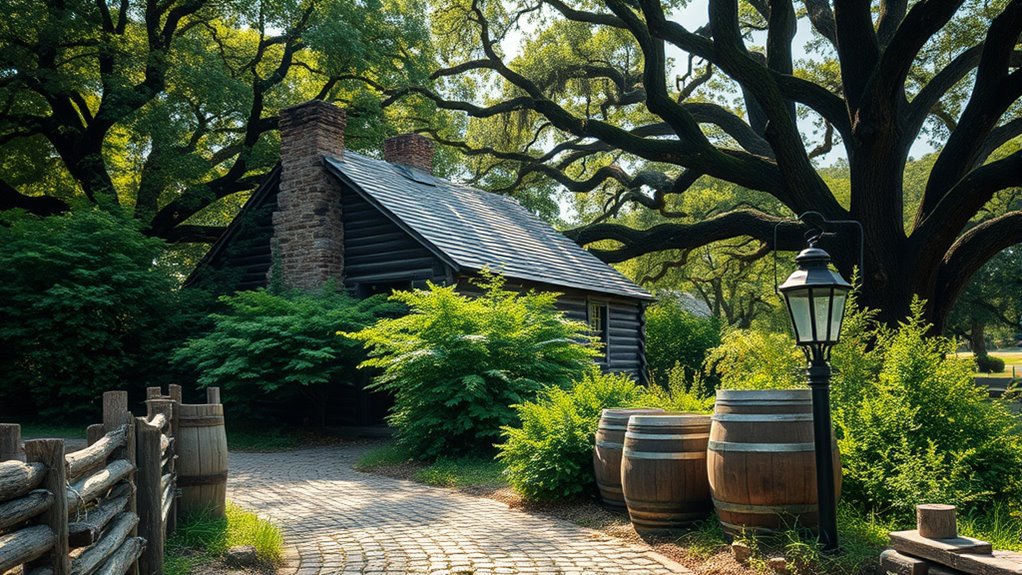
Have you ever wondered how the United States first took shape? It all began in 1607 when the English established Jamestown, the first permanent settlement in North America. This marked the start of sustained European colonization. In the Southern colonies, a plantation economy developed, relying heavily on enslaved labor to produce tobacco, rice, and indigo. Religious movements like the First Great Awakening in the 1730s–1740s stirred change across society, encouraging personal faith and challenging traditional authority. Meanwhile, the French and Indian War from 1754–1763 strengthened British control over North America but also created tensions with the colonies. During this period, distinct regional identities formed, influenced by economic pursuits and social customs in the North, South, and Middle colonies. The development of educational toys during this era also played a role in shaping early colonial education and literacy.
The Revolutionary Spirit and Formation of a New Nation

You see, the colonies grew frustrated with British taxes and restrictions, fueling the desire for independence. This revolutionary spirit led to the Declaration of Independence and a fierce fight for freedom. After winning the war, you helped shape a new government that balanced power and protected individual rights. Implementing a system like the Constitution was essential to ensure the stability and fairness of the newly formed nation.
Causes of Revolution
The revolutionary spirit that fueled the American colonies grew from a combination of economic, political, and social grievances against British rule. You felt taxed without representation, especially with acts like the Stamp and Townshend taxes. You resented the lack of colonial voice in government, culminating in protests like the Boston Tea Party. Socially, you grew restless under British interference, yearning for independence and self-governance. The table below highlights key causes:
| Cause | Impact | Example |
|---|---|---|
| Taxation Without Representation | Fueled anger and protests | Stamp Act, Tea Act |
| Restrictive Trade Policies | Hurt colonial economy | Navigation Acts |
| Growing Colonial Identity | Fostered desire for independence | Committees of Correspondence |
| British Military Presence | Increased tensions and violence | Boston Massacre |
Additionally, the desire for self-determination and control over local affairs further intensified the revolutionary movement.
Formation of Government
The revolutionary spirit that ignited the American colonies pushed them to challenge British authority and seek independence. You, as a colonist, felt the need to create a government that protected your rights and represented your interests. After declaring independence in 1776, you fought in the Revolutionary War to secure freedom. Once victorious, you helped draft the Articles of Confederation, establishing a loose federal government. Recognizing its weaknesses, you then supported the U.S. Constitution in 1787, creating a stronger, balanced federal system. The Bill of Rights, ratified in 1791, guaranteed your individual liberties and limited government power. These foundational documents and debates shaped your new nation’s government, emphasizing popular sovereignty, checks and balances, and the protection of your rights, setting the stage for America’s growth.
Civil War, Emancipation, and Reconstruction
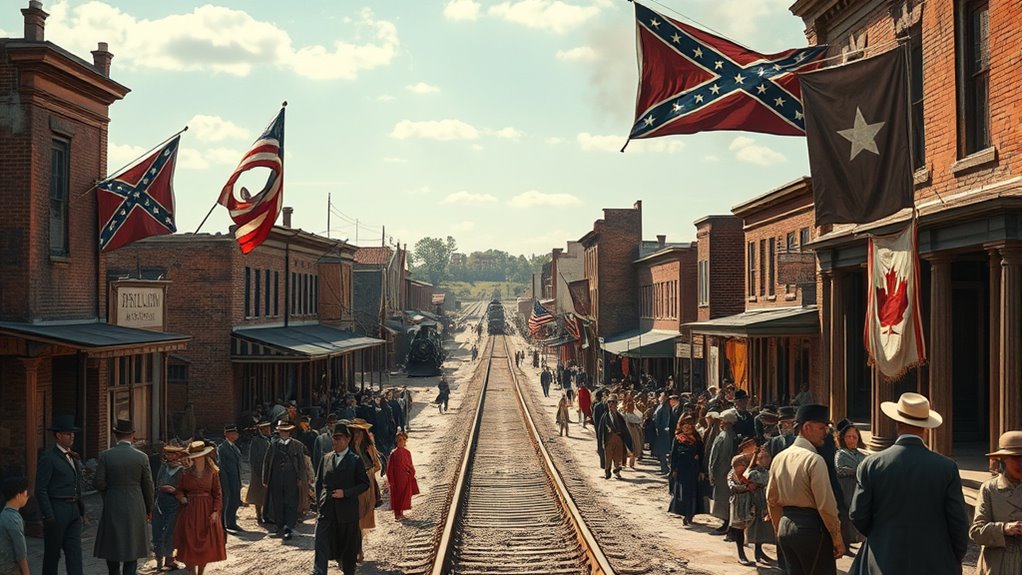
Have you ever wondered what sparked the Civil War and how it transformed American society? The conflict arose from deep divisions over slavery, states’ rights, and economic differences between the North and South. When Abraham Lincoln issued the Emancipation Proclamation in 1863, it shifted the war’s focus to ending slavery. The Battle of Gettysburg marked a turning point, leading to a Union victory. The war ended in 1865, and the Thirteenth Amendment abolished slavery nationwide. Reconstruction followed, aiming to rebuild the South and grant rights to freed slaves through the Fourteenth and Fifteenth Amendments. Although the war ended slavery, it also left lasting scars, shaping racial and political tensions that influence the nation even today. Decoding slang helps us understand the informal language that often reflects cultural shifts during these periods.
Industrial Growth and Urban Transformation
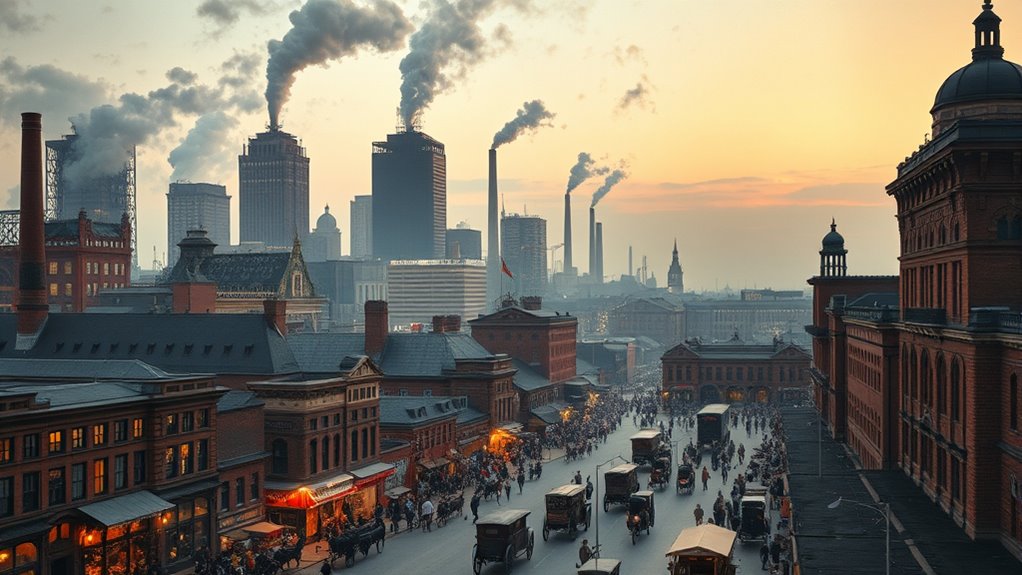
During the late 19th century, rapid industrial growth transformed the American economy and society. You see factories popping up in cities, producing everything from steel to textiles, fueling economic expansion. Railroads expand across the country, connecting regions and facilitating trade, while entrepreneurs like Carnegie and Rockefeller build powerful industrial empires. Urban areas swell as millions move from rural regions seeking factory jobs, creating bustling, crowded cities. This migration sparks a consumer culture, with department stores and mass-produced goods becoming common. However, this growth also brings social tensions—poor working conditions, labor strikes, and rising nativism. Technological innovations, such as refrigerated railcars and telegraphs, revolutionize communication and commerce. Additionally, advancements in industrial manufacturing techniques contribute to the mass production of goods, further transforming urban life and the economy. Overall, this era reshapes America into an industrial powerhouse and transforms its urban landscape.
The United States in the World Wars and the Great Depression
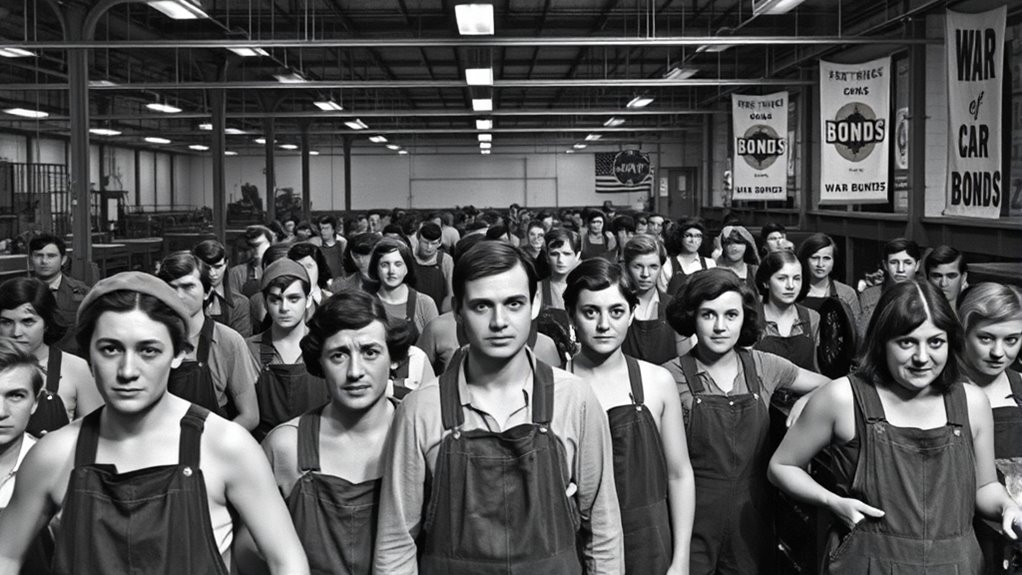
Industrial growth in the late 19th century positioned the United States as a rising global power, but it also set the stage for major involvement in world conflicts. During the World Wars, you saw the U.S. shift from neutrality to active participant, boosting military and industrial strength. The Great Depression hit hard, causing unemployment and economic collapse, but it also led to reforms like the New Deal to rebuild the economy. You experienced:
- Entry into WWI in 1917, helping turn the tide in Europe
- World War II involvement after Pearl Harbor in 1941
- Economic recovery fueled by war production
- The Cold War’s beginning, shaping foreign policy
- Social changes driven by wartime mobilization and economic shifts
These events transformed the U.S., establishing its role as a superpower and influencing global affairs for decades. Seasonal variations also enhanced the experience, as different times of year brought unique challenges and opportunities for Americans during these pivotal moments.
Social Movements and Civil Rights Progress

You’ve seen how social movements have pushed for equality and justice throughout U.S. history. Civil rights legislation has played a crucial role in transforming laws and protecting individual freedoms. These efforts continue to shape the fight against systemic inequality today. Understanding the importance of Gold IRA Rollovers can also be a part of securing long-term financial stability for future generations.
Civil Rights Legislation
How did the fight for equality reshape American society? Civil rights legislation transformed the nation by ending legal segregation and protecting individual freedoms. It marked a major step toward true equality, empowering marginalized communities and challenging systemic racism. You saw landmark laws like the Civil Rights Act of 1964 and the Voting Rights Act of 1965, which fought discrimination in employment, public accommodations, and voting. These laws helped dismantle institutional barriers and inspired ongoing activism. The implementation of skincare patches as targeted treatments exemplifies how small, strategic interventions can have a significant impact on personal health and well-being. Civil rights legislation created a foundation for a more inclusive America, though challenges still remain today.
Social Movement Impact
Civil rights legislation laid the groundwork for a more equitable society by dismantling legal barriers and protecting individual freedoms. As you witness the impact of social movements, you see how activism has driven change, inspiring laws like the Civil Rights Act of 1964 and the Voting Rights Act of 1965. These movements give voice to marginalized groups, challenging segregation, discrimination, and inequality. You notice how protests, sit-ins, and marches mobilize communities and influence public opinion. Over time, these efforts lead to policy reforms and cultural shifts, fostering greater inclusion. Today, social movements continue to shape the nation, addressing issues like systemic racism and inequality. Your participation and awareness help sustain progress, ensuring civil rights advancements remain a crucial part of American history.
Technological Innovations and Space Exploration
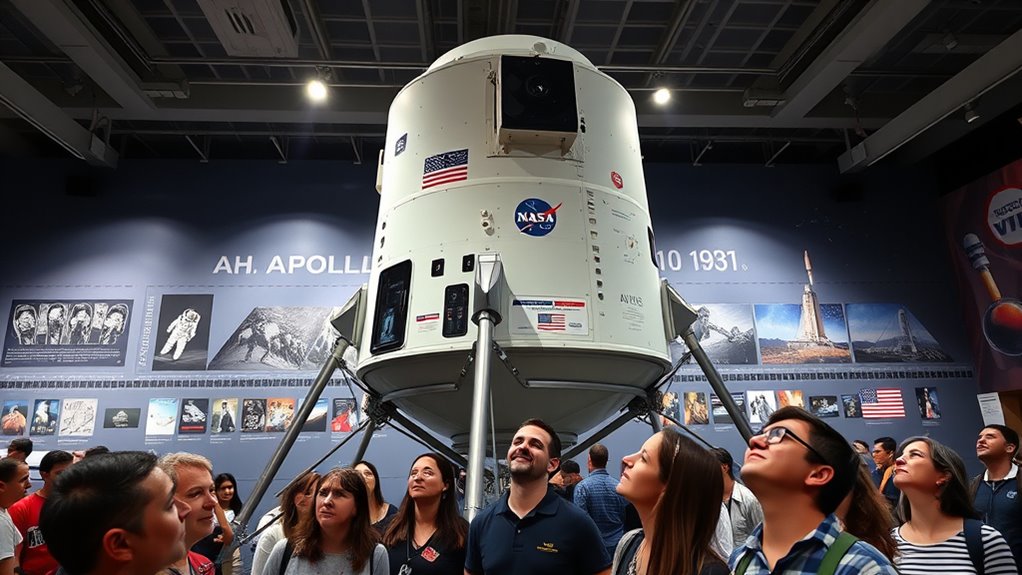
Have technological innovations truly transformed the United States into a leader in space exploration? Absolutely. You’ve seen how NASA’s Apollo missions put a man on the moon in 1969, a milestone that showcased American ingenuity. Today, the U.S. continues pushing boundaries with reusable rockets, satellite technology, and private companies like SpaceX driving progress. These innovations have made space more accessible and opened new frontiers for science and commerce. You can appreciate how advancements like GPS, weather forecasting, and space telescopes have become part of everyday life. The U.S. remains at the forefront with cutting-edge research and exploration efforts, inspiring new generations to dream beyond our planet. technological innovations continue to evolve, shaping the future of space endeavors.
Post-War Politics and Cultural Shifts

After World War II, the United States experienced significant political and cultural shifts that shaped its modern identity. You see, the Cold War rivalry with the Soviet Union fueled national security concerns and led to increased government surveillance and defense spending. Politically, the era brought about a shift toward conservatism in the 1950s, emphasizing traditional values and anti-communism. Culturally, the 1960s and 70s sparked social upheaval, with movements advocating for civil rights, gender equality, and anti-war protests. Television became a dominant medium, shaping public opinion and consumer culture. Meanwhile, the post-war prosperity fostered suburbanization and consumerism, but also highlighted racial and social inequalities that sparked ongoing debates about justice and equality. These shifts fundamentally transformed American society and politics. Additionally, the development and widespread adoption of modern fraud detection techniques played a crucial role in safeguarding financial transactions during this transformative period.
Contemporary Challenges and Social Movements
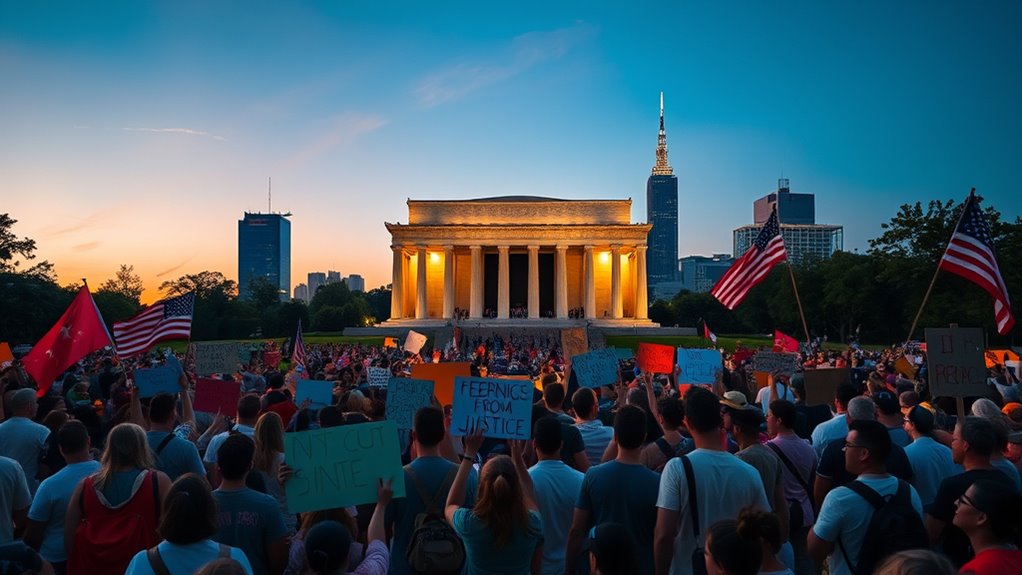
What are the biggest challenges facing the United States today, and how are social movements shaping the response? You see, issues like racial inequality, economic disparity, climate change, political polarization, and gun violence dominate the national conversation. Social movements are fueling change by raising awareness, mobilizing communities, and demanding policy reforms. They push leaders to act and hold institutions accountable.
Social movements drive change on racial, economic, environmental, and political issues in America today.
- Black Lives Matter protests spotlight racial injustice and police brutality
- Climate strikes urge action on environmental crises
- MeToo movement exposes harassment and promotes gender equality
- Immigration advocacy fights for immigrant rights and reform
- Voting rights campaigns challenge restrictions and promote civic participation
These movements shape public opinion, influence legislation, and redefine American values, making society more inclusive and responsive to its diverse population.
The Evolving Identity and Global Influence of the USA
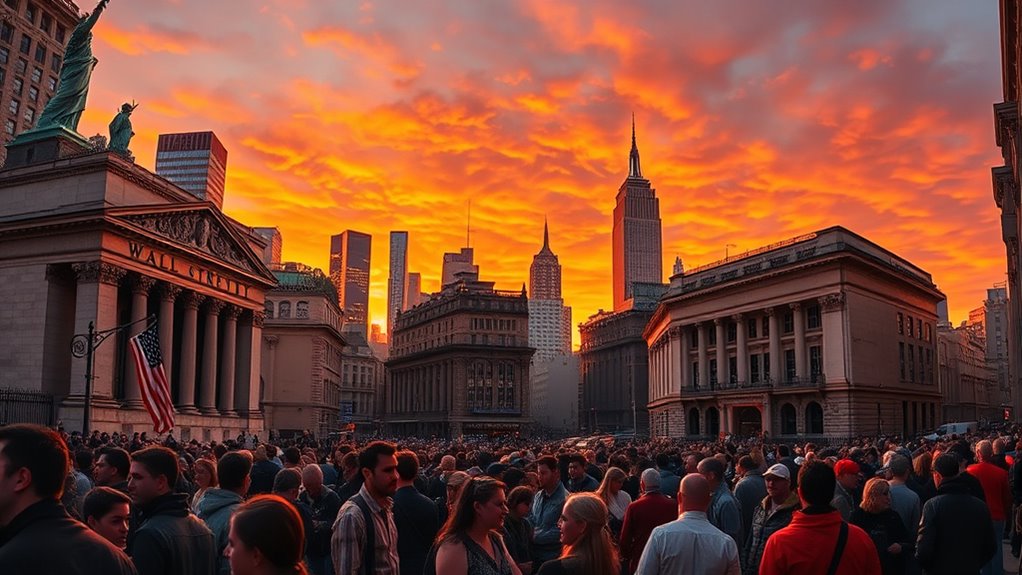
The United States’ identity has continually evolved alongside its growing influence on the world stage. You witness a nation shaped by innovation, resilience, and diverse cultural roots. As a global leader, you see how America’s military, economy, and technology drive international affairs, shaping policies and alliances. Yet, you also recognize internal debates about values, identity, and global responsibility. The U.S. has shifted from a frontier nation to a superpower, influencing global culture through music, film, and technology. You observe how diplomacy, economic strength, and soft power shape its reputation. Despite challenges like political polarization and social inequality, America’s foundational ideals of liberty, democracy, and opportunity continue to inspire and define its evolving role worldwide.
Frequently Asked Questions
How Did Indigenous Peoples Influence Early American History and Culture?
You see indigenous peoples crucially shaped early American history and culture through their rich traditions, languages, and knowledge of land management. They introduced farming techniques, such as maize cultivation, and played essential roles in trade networks. Their resistance and alliances influenced colonial dynamics, while their spiritual beliefs and art deeply impacted American cultural development. Recognizing their contributions helps you understand the foundation of the nation and its diverse identity.
What Role Did Women Play in Shaping America’s Development?
Women, like quiet architects of change, shaped America’s development through resilience and innovation. You see them tending farms, running businesses, and leading social movements that challenged norms. Their voices fueled abolition and women’s suffrage, planting seeds of equality that grew over time. In every struggle and breakthrough, women’s quiet strength and fierce determination built the foundation for a more inclusive nation. Their impact echoes in America’s ongoing story of progress.
How Did American Literature Evolve Through Different Historical Periods?
You see American literature evolve as writers reflect the changing times. During early periods, figures like Franklin focused on moral essays and colonial identity. Romanticism in the 19th century brought authors like Poe and Hawthorne, exploring individualism and dark themes. Modern writers like Fitzgerald and Hemingway captured the Jazz Age’s vibrancy and disillusionment, while contemporary authors address social issues, diversity, and globalization. Your understanding grows as literature mirrors America’s shifting values and struggles.
In What Ways Did Immigration Shape American Societal Values?
Did you know that between 1820 and 1920, over 30 million immigrants arrived in the U.S.? Immigration profoundly shapes your societal values by bringing diverse cultures, languages, and religions, fostering a multicultural identity. You experience this diversity in food, traditions, and ideas, which challenge and enrich your community. It promotes values like tolerance, innovation, and resilience, making America a dynamic and vibrant society that continually evolves through its immigrant roots.
How Has American Music Reflected Social and Political Changes?
You see American music reflecting social and political changes through powerful lyrics and diverse genres. During the Civil Rights Movement, songs like “We Shall Overcome” inspired hope and unity. Protest songs of the 1960s and 70s, like Bob Dylan’s, voiced dissent. Today, artists address issues like racial injustice and inequality, using music as a platform to challenge societal norms and push for change.
Conclusion
You’ve seen how the USA’s history is a tapestry of resilience and innovation. Did you know that over 4 million people served in the military during World War II, shaping its global influence? From early settlements to modern social movements, your country’s journey reflects a spirit of perseverance. As you look ahead, remember that each chapter builds a foundation for a future still being written—one that continues to inspire and evolve.

